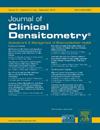Influence of two strength training modalities (hypertrophy vs. contrast training) on muscular strength, bone health parameters and quality of life in a group of older adults with low skeletal muscle mass index
IF 1.6
4区 医学
Q4 ENDOCRINOLOGY & METABOLISM
引用次数: 0
Abstract
The main aim of the current study was to compare the effects of two strength training modalities (hypertrophy vs. contrast training) on bone health parameters, physical performance and quality of life in a group of subjects aged 60 and above with low skeletal muscle mass index (SMI). 45 older adults voluntarily participated in this study, but only 41 (22 women and 19 men) completed it. The participants were assigned to 3 different groups: control group (CG; n = 15), contrast training group (CTG; n = 13) and hypertrophy training group (HTG; n = 13). The duration of the training protocol was six months. The experimental groups performed two sessions of strength training per week; the duration of each session was forty-five minutes. Several measurements (which included anthropometrics, body composition, bone parameters, maximal strength parameters, physical performance parameters, fracture risk and quality of life) were performed in the three groups before and after the six-month training period. The different measurements of the protocol were carried out under the same conditions with identical materials and investigators for all the participants and for each approach. The current study has demonstrated that the two training modalities show common benefits such as improving maximal strength, physical performance and quality of life parameters but have no significant effects on bone mineral density (BMD) and bone mineral content (BMC). The influence of training was marked more for improving maximal strength and reducing fracture risk for the contrast training group (who performs movements at high speed) compared to the hypertrophy training group (who performs movements at spontaneous speed). In conclusion, this study shows that both resistance training programs are effective in improving maximal strength, physical performance and quality of life in older adults with low SMI. However, this 6-month intervention was not sufficient to significantly increase BMC nor BMD values in this population.
两种力量训练方式(肥厚训练与对比训练)对一组骨骼肌质量指数低的老年人肌肉力量、骨骼健康参数和生活质量的影响
本研究的主要目的是比较两种力量训练方式(肥厚训练和对比训练)对60岁及以上低骨骼肌质量指数(SMI)受试者的骨健康参数、身体表现和生活质量的影响。45名老年人自愿参加了这项研究,但只有41人(22名女性和19名男性)完成了这项研究。参与者被分为三个不同的组:对照组(CG);n = 15),对照训练组(CTG;n = 13)和肥大训练组(HTG;n = 13)。培训协议的期限为6个月。实验组每周进行两次力量训练;每次会议的持续时间为45分钟。在六个月的训练前后,对三组进行了多项测量(包括人体测量学、身体成分、骨骼参数、最大力量参数、物理性能参数、骨折风险和生活质量)。该方案的不同测量是在相同的条件下,对所有参与者和每种方法使用相同的材料和调查员进行的。目前的研究表明,这两种训练方式都有共同的好处,如提高最大力量、身体表现和生活质量参数,但对骨矿物质密度(BMD)和骨矿物质含量(BMC)没有显著影响。与肥厚训练组(以自然速度进行运动)相比,训练在提高最大力量和降低骨折风险方面的影响更明显。总之,本研究表明,两种抗阻训练方案都能有效地提高低重度精神障碍老年人的最大力量、身体表现和生活质量。然而,这6个月的干预不足以显著增加该人群的BMC和BMD值。
本文章由计算机程序翻译,如有差异,请以英文原文为准。
求助全文
约1分钟内获得全文
求助全文
来源期刊

Journal of Clinical Densitometry
医学-内分泌学与代谢
CiteScore
4.90
自引率
8.00%
发文量
92
审稿时长
90 days
期刊介绍:
The Journal is committed to serving ISCD''s mission - the education of heterogenous physician specialties and technologists who are involved in the clinical assessment of skeletal health. The focus of JCD is bone mass measurement, including epidemiology of bone mass, how drugs and diseases alter bone mass, new techniques and quality assurance in bone mass imaging technologies, and bone mass health/economics.
Combining high quality research and review articles with sound, practice-oriented advice, JCD meets the diverse diagnostic and management needs of radiologists, endocrinologists, nephrologists, rheumatologists, gynecologists, family physicians, internists, and technologists whose patients require diagnostic clinical densitometry for therapeutic management.
 求助内容:
求助内容: 应助结果提醒方式:
应助结果提醒方式:


